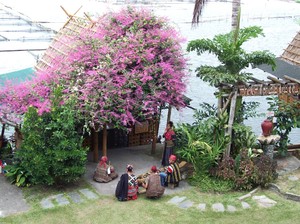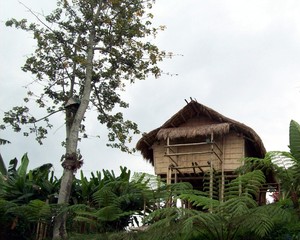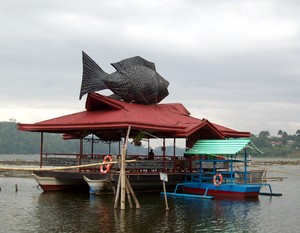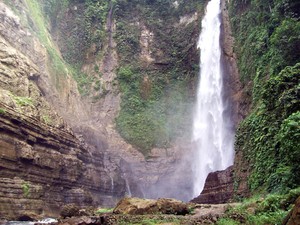Text and Photos by Henrylito D. Tacio
Davao City, 10 February 2010. When bestselling Lonely Planet described Lake Sebu in South Cotabato as a place located in a “bowl of forests and mountains,” it was totally true! After all, its 92,450-hectare landscape was proclaimed by the Philippine government as a protected area. As such, you can still pristine forests at its best. Being one of the most important watershed areas in the country, you get a glimpse of many small streams, creeks, rivers, springs – not to mention endemic flora and fauna.
That was we – my friend Jose Rey L. Subaldo and I – discovered when we visited the place recently. We had to travel about half a day from Davao City via General Santos to get to Lake Sebu. Although we stayed only for two days, we can say that the travel was worth it!

T'bolis - dreamweavers.
As one foreigner, who visited the place, puts it: “Lake Sebu is a beautiful inland sea on the island of Mindanao and is nested into the southern highlands at an altitude of almost 300 meters (984 feet). Lake Sebu is surrounded by rolling hills and forested mountains and is home to the T’boli, a highland tribe famous for their colorful costumes, intricate beadwork, woven work and brass ornaments.”
The T’bolis are the indigenous peoples of Lake Sebu. According to legends, they are descendants of the survivors of a great flood. A man named Dwata warned the people of an impending great flood. But the tribe refused to listen, except for two couples, La Bebe and La Lomi, and Tamfeles and La Kagef. Dwata told them to take shelter in a bamboo so huge they could fit inside and in this way survive the flood. The first couple was the ancestors of the T’boli and other highland ethnic groups. The second couple descended the other Filipino indigenous groups.
The T’bolis are noted for their t’nalak, a sacred cloth made from abaca which is exchanged during marriages and used as a cover during births. “The T’boli t’nalak is distinctive for its overall tie-dyed design patterns laid on the entire surface of the cloth,” hailed the National Commission for Culture and Arts (NCAA). “The highly stylized repetitive patterns depicting amphibious forms and plant elements pulsate in rhythmic cadence in definite hues of rust red, deep brown, and satin black against the light sepia hue of the abaca fiber.”

Lake Sebu gives a top of the world feeling.
One of the famous dreamweavers, as T’boli weavers as known since the tribal designs are derived from a dream, is Lang Dulay. Only 12 when she first learned how to weave, she was chosen by the NCAA as one of the two Gawad sa Manlilikha ng Bayan recipients in 1998 (the other was the late Salinta Monon of Bansalan, Davao del Sur).
“Through her weaving, Lang Dulay does what she can to keep her people’s tradition alive,” the NCAA noted. She reportedly knows a hundred designs, including the bulinglangit (clouds), the bankiring (hair bangs), and the kabangi (butterfly).
Since the town is an ancestral domain, a visit to Lake Sebu is not complete without coming to the T’boli Museum. In the museum, which is actually a T’boli house, you can see colorful costumes, bead accessories, brass made products and other souvenir items. You can also see the clay pots used by T’bolis in cooking their food. You can even play the musical instruments – if you know how!
Aside from T’bolis, Lake Sebu is also home of the Tasadays, the cave-dwelling and primitive, stone-age tribe that lived in isolation in high caves of the primary rain forest area. The Department of Environment and Natural Resources have recognized the claim of both tribes that the lake and its surroundings are under their ancestral domain.
Lake Sebu got its name from the biggest of the three lakes. Criselda B. Dioso, a T’boli native who briefed us about the town, said the placid lake of Lake Sebu measures 354 hectares. The two other lakes are smaller; Lake Seloton is only 48 hectares while Lake Lahit is 24 hectares.

Enjoy fresh seafood at the floating restaurant.
There’s a local myth on how Lake Sebu came to be. A time ago, a local princess had a dream of coming to the mountain lands of Sebu. The princess saw a big leaf. When she opened it up a white frog leaped out along with a gush of water which flooded the land and became the lake. From the heavens she threw here pythons to the earth which formed the islands at the lake. And in order for the princess to pass by the lake, her brother parted the islands. The name “Sebu” actually came from the T’boli word for lake or leaf.
Although there are 11 islands within the lakes, only three are inhabited while others are privately-owned. The largest among the islands is named Isla Grande (which looks like a sleeping crocodile). Most of smaller islands are privately owned.
“Most of the people living in these islands are engaged in fishing,” points out Joemar Z. Alaza, the operations manager of Punta Isla Lake Resort, where we stayed. In the early 1980s, the lake became famous for tilapia raising that eventually triggered the mushrooming of the fish cages until more than half of it was almost covered.
The government saw the problem. So much so that today, fish cages are built 15 meters away from the shore. The Philippine Fisheries Code provides that fish cages should occupy at most only 10 percent of the total lake area to prevent the quality of Lake Sebu from deteriorating.
It is one thing seeing the lake from afar, but it’s another thing exploring the actual lake itself. At Punta Isla Lake Resort, you could hire a motor boat good for 8-10 persons in addition to your personal tour guide and boat man. Their tour guides are native T’bolis and are accredited by the Department of Tourism, so you get loads of information as well as stunning views of the lake during the boat ride.
Aside from the three lakes, Lake Sebu is also famous for its seven waterfalls, a series of river drops along the lush mountain forests.
Named after the number of falls that interconnect, the falls derive its water from the lake. Only two are accessible; the others have yet to have access trails.

First Waterfall.
The First Waterfall, as they call it, is a block type of waterfall, owing to the large lake that feeds it. The rapid gush and fall of waters from some 40 feet above makes traversing the river dangerous near its plungpool.
The Second Waterfall, a plunge type, is truly majestic with a height of more than 100 feet. Even from a distance, the fall is magnificent! The very small tributary is almost inconspicuous but the rapids and the falling water from heights is just too astounding. Its location is also mind boggling. It looks like it was actually etched like a crater in a mountain side with different layers of rock representing geological times clearly lined up in the in the overhang. At 80 feet, you can still feel the cold mist from the turbulent waters at the plungpool.
If you among those who don’t like to trek, you can view the falls through a zipline. At a height of 700 meters, from one point to another, you can see the awesome view over the First Waterfall up to the Fifth Waterfall. To return, take the 400 meter zip from Fifth Waterfall to Second Waterfall. “Sure, seeing the waterfalls from zip was totally exciting,” Jay said.

Second Waterfall.
So, what else you can do while in Lake Sebu? The United Nations declared 2010 as the International Year of Biodiversity. As such, Lake Sebu should be one of the tourist destinations this year. Wild boars and Philippine deer, both considered endangered animals, live around the lake. The lake and the surrounding rainforest are natural habitat to egrets, kingfishers, swallows, herons, Philippine cockatoos, and kites. If you are lucky enough, you might also see an endangered tarsier near the lush forests of seven waterfalls.
If Baguio is the summer capital of the Philippines, Lake Sebu is the summer capital of Southern Mindanao. Its climate is cool because it has an estimated elevation of 1,000 meters (3,000 feet) high from sea level. At night, the temperature gets cold and is pleasurable for those who seek the highlands and mountain feel.
One visitor observed: “I can attest to this as the air here is very cool especially at nights where air conditioning is no longer needed. In fact, there was a short brownout one night while we were sleeping but it didn’t matter since it was very cool anyway. Unlike its northern counterpart of Baguio, the air here is still fresh and most of the structures are still the native huts and houses. And due to this elevation, most of the time the sky can become gray and cloudy, and at times we heard the place is covered with fog with a limited visibility of a couple of feet or more.”
There are several resorts in the town but we opted to stay at Punta Isla Lake Resort. It is owned by Edna Solivio, which started as a vacation house in 1996. In 1999, it became a resort and now hosts 2,000 visitors, including those who attend training and conferences.
Its famous guests include former president Fidel V. Ramos, tourism secretary Ace Durano, Asia’s songstress Pilita Corales, film actor Carlo Maceda, television host Edu Manzano, and presidential aspirant Manny Villar.
One good thing about Punta Isla is you can have fine dining at their floating restaurant, just a few meters away from the resort. Imagine the cool weather, the breathtaking views, and the freshly grilled tilapia. Other tilapia delicacies they served includechicharon tilapia, tilapia foyong, tilapia rebusado, tilapora, kinilaw na tilapia, nilasing na tilapia, pinaputok na tilapia, and daing natilapia.
How do you get to Lake Sebu? From the bus terminal in General Santos City, take bus to Koronadal (often referred to as Marbel, its old name) and get off at the Koronadal bus station. Tell the conductor to drop you off there. The trip is about 45 minutes. From Koronadal, take the Yellow Bus to the town of Surralah (about 38 minutes). From Surralah, take a jeep to Lake Sebu (about 43 minutes).